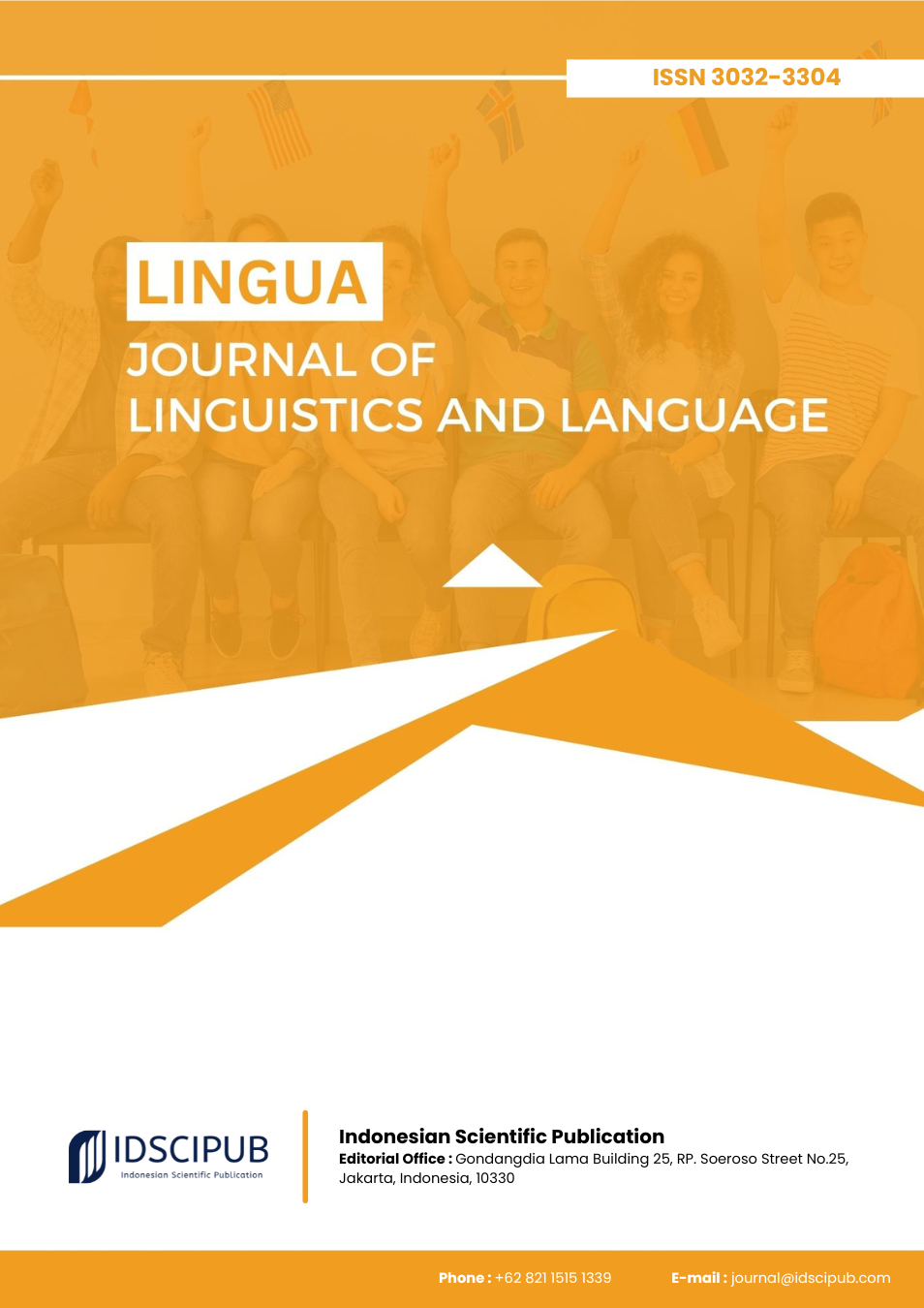Sexism Representation “Train her to be an Ideal Housewife” Ads: Sara Mills Theory
DOI:
https://doi.org/10.61978/lingua.v2i1.455Keywords:
Advertising, Discourse Analysis, Gender Representation, Sexism, WomenAbstract
This study examines linguistic sexism and the portrayal of women in Indian advertising media. It aims to highlight how advertisements reinforce gender stereotypes and contribute to societal inequality. The research employs a qualitative approach with descriptive analysis, using Sara Mills' discourse-level analysis theory from Feminist Stylistics (1995) as the analytical framework. The analysis identifies indirect sexism and the objectification of women in advertising. Women are frequently depicted as housewives rather than independent individuals with career aspirations. These portrayals reinforce traditional gender roles, limiting women's representation in diverse professional and social spheres. The study concludes that gender equality remains unachieved in Indian advertising media, as women continue to be stereotyped and confined to domestic roles. The persistence of these portrayals reflects deep-rooted societal biases that restrict women’s opportunities. By shedding light on gender bias in advertising, this study emphasizes the need for more inclusive and equitable media representations. Addressing these stereotypes can contribute to social change and the promotion of gender equality in India.
References
Achsani, F., & Inderasari, E. (2018). Strategi Komunikasi dalam Kesantunan Berbahasa Komunitas Antarsantri Pondok Pesantren Al-Hikmah Sukoharjo. SEMIOTIKA: Jurnal Ilmu Sastra Dan Linguistik, 19(1), 57. https://doi.org/10.19184/semiotika.v19i1.8309 DOI: https://doi.org/10.19184/semiotika.v19i1.8309
Benwell, B. (2007). NEW SEXISM? Journalism Studies, 8(4), 539–549. https://doi.org/10.1080/14616700701411797 DOI: https://doi.org/10.1080/14616700701411797
Creswell, J. W. (2014). Research Design: Qualitative, Quantitative, and Mixed Methods Approaches. Thousand Oaks.
Das, M. (2011). Gender Role Portrayals in Indian Television Ads. Sex Roles, 64(3–4), 208–222. https://doi.org/10.1007/s11199-010-9750-1 DOI: https://doi.org/10.1007/s11199-010-9750-1
Deloitte. (2022). India sees more women in leadership roles but boardroom diversity progressing at a snail’s pace. Deloitte India; Deloitte India. https://www2.deloitte.com/in/en/pages/risk/articles/India-sees-more-women-in-leadership-roles-but-boardroom-diversity-progressing-at-a-snails-pace.html
Dwivedy, A. K., Patnaik, P., & Suar, D. (2009). Audience Response to Gender Role Portrayals in Indian Advertisements. Journal of Creative Communications, 4(2), 65–85. https://doi.org/10.1177/097325861000400201 DOI: https://doi.org/10.1177/097325861000400201
Fitriyah, A. (2024). Sexist Utterance and Gender Stereotyping in the Novel Queen Alexine: Sara Mills’ CDA Approach. PAROLE: Journal of Linguistics and Education, 2, 1.
Ganito, C. (2012). Moving Time and Juggling Spheres. Feminist Media Studies, 12(4), 570–579. https://doi.org/10.1080/14680777.2012.741874 DOI: https://doi.org/10.1080/14680777.2012.741874
Grau, S. L., & Zotos, Y. C. (2016). Gender stereotypes in advertising: a review of current research. International Journal of Advertising, 35(5), 761–770. https://doi.org/10.1080/02650487.2016.1203556 DOI: https://doi.org/10.1080/02650487.2016.1203556
Kannan, A. (2020). Indian women spend 299 mins in a day doing unpaid work, men spend 99 mins. The News Minute. https://doi.org/https://www.thenewsminute.com/news/indian-women-spend-299-mins-day-doing-unpaid-work-men-spend-99-mins-134393
Knoll, S., Eisend, M., & Steinhagen, J. (2011a). Gender roles in advertising. International Journal of Advertising, 30(5), 867–888. https://doi.org/10.2501/IJA-30-5-867-888
Knoll, S., Eisend, M., & Steinhagen, J. (2011b). Gender roles in advertising. International Journal of Advertising, 30(5), 867–888. https://doi.org/10.2501/IJA-30-5-867-888 DOI: https://doi.org/10.2501/IJA-30-5-867-888
Masitoh. (2020). PENDEKATAN DALAM ANALISIS WACANA KRITIS. Edukasi Lingua Sastra, 18(1), 66–76. https://doi.org/10.47637/elsa.v18i1.221 DOI: https://doi.org/10.47637/elsa.v18i1.221
Mills, S. (1995). Feminist Stylistic. Routledge.
Mills, S. (2008). Language and Sexism. Cambridge University Press.
Motschenbacher, H., & Hellinger, M. (2015). Gender across Languages. John Benjamins Publishing Company.
Patrick, B. A., & Thrall, T. A. (2007). Beyond Hegemony: Classical Propaganda Theory and Presidential Communication Strategy After the Invasion of Iraq. Mass Communication and Society, 10(1), 95–118. https://doi.org/10.1080/15205430709337006 DOI: https://doi.org/10.1080/15205430709337006
Plakoyiannaki, E., & Zotos, Y. (2009). Female role stereotypes in print advertising. European Journal of Marketing, 43(11/12), 1411–1434. https://doi.org/10.1108/03090560910989966 DOI: https://doi.org/10.1108/03090560910989966
Pratama, H. (2018). Identifying Sexist Language On Youtube Comment Section”. In C. I. R. all (Ed.), Language in the Online and Offline World 6: The Fortitude. Petra Press.
Sandhu, N. (2018). Impact of Gender Cues in Advertisements on Perceived Gender Identity Meanings of the Advertised Product. FIIB Business Review, 7(4), 293–303. https://doi.org/10.1177/2319714518805829 DOI: https://doi.org/10.1177/2319714518805829
Sarkar, S. (2015). Gender Stereotyping in Product Promotion: A Dominant Tool of Advertising in Indian Media. International Journal of Media, Journalism and Mass Communications (IJMJMC, 1(2), 1–12.
Taylor, K. A., Miyazaki, A. D., & Mogensen, K. B. (2013). Sex, Beauty, and Youth: An Analysis of Advertising Appeals Targeting U.S. Women of Different Age Groups. Journal of Current Issues & Research in Advertising, 34(2), 212–228. https://doi.org/10.1080/10641734.2013.787581 DOI: https://doi.org/10.1080/10641734.2013.787581
Titahena, M., Tabelessy, N., & Pessiwarissa, L. F. (2022). KESANTUNAN BERBAHASA DALAM INTERAKSI ANAK MUDA MALUKU LEWAT MEDIA SOSIAL FACEBOOK. ARBITRER: Jurnal Pendidikan Bahasa Dan Sastra Indonesia, 3(3), 527–534. https://doi.org/10.30598/arbitrervol3no3hlm527-534 DOI: https://doi.org/10.30598/arbitrervol3no3hlm527-534
UNDP. (2021). Gender equality and social inclusion. UNDP. https://www.undp.org/indonesia/gender#:~:text=The%20GII%20values%20between%200,women%20in%20the%20three%20dimensions.
WHO. (2021). Long Working Hours Increasing Deaths from Heart Disease and Stroke. In World Health Organization. https://www.who.int/news/item/17-05-2021-long-working-hours-increasing-deaths-






